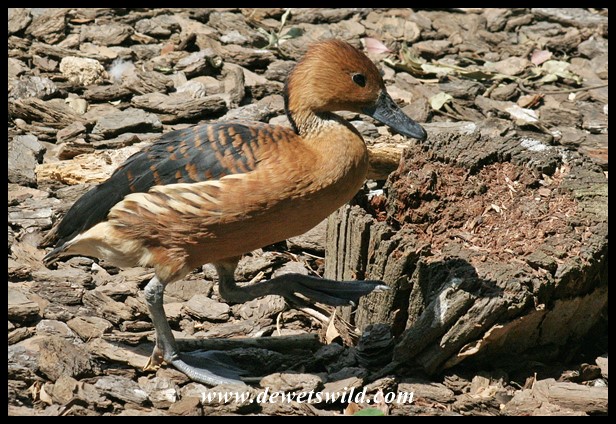Dendrocygna bicolor
Probably as is to be expected, the long-legged Fulvous Whistling Duck is usually found at or near bodies of fresh water, usually with well vegetated verges where it follows a mainly herbivorous diet that includes algae, grasses, water lilies, seeds and flowers and only occasionally taking in insects and other invertebrates. They are quite nomadic waterfowl, ranging widely in search of suitable habitat, and often found in association with the closely-related White-faced Whistling Duck. The Fulvous Whistling Duck is not often found in large flocks, usually moving around and feeding in fairly small groups. They are active both day and night.
Fulvous Whistling Ducks may breed at anytime of year, though most often shortly after good rains. Their nests are simple scrapes in the ground, usually in dense cover very near water and lined with fine plant materials. Pairs are monogamous and may mate for life. Both parents contribute to the building of the nest and the incubation of the clutch of 6-13 eggs, which hatch after about four weeks. The ducklings can fly before they’re 2 months old.
The Fulvous Whistling Duck is widely distributed over parts of Africa, Asia, North and South America, and is considered to be of least concern; the IUCN estimating the total population at as much as 1.5-million though noting that most populations are declining due to hunting and farming practices. In South Africa they are commonly found on the Highveld (mainly Gauteng) but only occasionally seen in the wild elsewhere in our country.















Definitely a good looking duck – it is such a gorgeous cinnamon colour and I really like the feathery white stripes along the flanks.
LikeLiked by 1 person
I wasn’t familiar with the word “fulvous” prior to putting together this post. Not being an English first language speaker I hope I can be forgiven, but I don’t think it is used very often? I had to google to see that it means “reddish yellow; tawny”. Who knew!? I bet you did though.
LikeLiked by 1 person
I didn’t know actually – it is an interesting word though and it seems it is really only applied to ducks?
LikeLiked by 1 person
I’ve only ever seen it used with this particular species
LikeLiked by 1 person
Hello Dries,
I agree, what a handsome duck. Whistling Ducks do not live here so I am happy to “view” them through your photos. I hope you and your family are staying safe!
LikeLiked by 1 person
They’re a real joy to behold, and hear, Takami.
We’re doing well, thanks, and looking forward to finally take a break at the end of the year. How are you?
LikeLiked by 1 person
Thank you my friend. Unfortunately, COVID-19 cases are continuing to rise in my country, but my husband and I are doing well. I am glad you and all your family are staying safe and healthy!!
LikeLiked by 1 person
Wonderful to hear that the two you are still safe and healthy too, Takami!
LikeLiked by 1 person
He’s such a handsome chap. I wonder who taught him to whistle? My dad taught me and my grandma didn’t approve at all. 🙂
LikeLiked by 1 person
Oh dear, Sylvia! What would the neighbours say? 😀
LikeLiked by 1 person
Exactly so. 😅She has this saying from who knows where, “A whistling woman and a crowing hen are good to neither God nor men.” 😳
LikeLiked by 1 person
Ouch!
LikeLiked by 1 person
Yes…….that along with ”Little girls should be seen but not heard.” 😳
LikeLike
I hope at least Granny had a purse full of sweets to help little girls with that difficult task!?
LikeLiked by 1 person
No, sweets were bad for our teeth. 😦
LikeLiked by 1 person
Handsome duck, one that does not live around where I am. Sigh …
LikeLiked by 1 person
Thankfully you have some real showy ducks of your own there, Hien!
LikeLike
What a bonny duck, Dries.
LikeLike
Beautiful colors and a name that makes me smile. Reminds me of the Frumious Bandersnatch. 😘
LikeLiked by 1 person
Do I dare google “Frumious Bandersnatch”, Janet?
LikeLike
Yes, it’s from “Jabberwocky.” 😉
LikeLiked by 1 person
That’s a relief! 😀
LikeLiked by 1 person
They sport a beautiful colouring. I particularly enjoy the photograph you have used for your header.
LikeLiked by 1 person
Thank you very much, Anne. I love their long-legged walk.
LikeLike
I’m always happy that they breed for life and both contribute to raising their young.
LikeLiked by 1 person
Sadly a lesson some humans struggle to learn.
LikeLiked by 1 person
Isn’t that the truth!
LikeLiked by 1 person
That’s a pretty “duckie”. Well known everywhere. I’ve seen it in South America, however, I don’t have a single photograph of them…It happens! Thanks, D. 🙂
LikeLiked by 1 person
They’re a personal favourite of mine too, H.J.
LikeLiked by 1 person